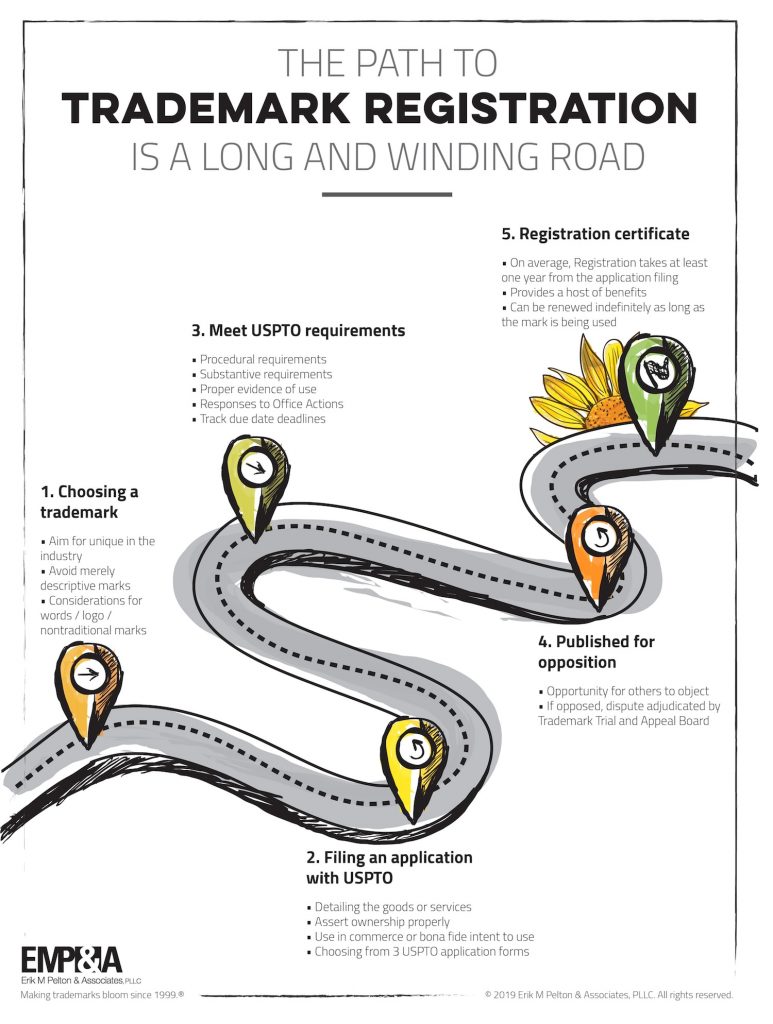The following is an edited transcript of Chapter 8 of my book video Building a Bold Brand: The Trademark Registration Process: A Long and Winding Road
The trademark application process at the United States Patent and Trademark Office (USPTO) is generally long, complex, and full of deadlines. It’s also full of bumps, potholes, detours, wrong exits, and toll booths. Errors have the potential to limit or jeopardize a brand owner’s trademark rights; result in a voided application; delay the application process; or result in the loss of non-refundable USPTO filing fees. But, the goal—a registered trademark—is worth the trip, as it strengthens a brand; creates tangible intellectual property assets; and, generally, makes it easier, quicker, and cheaper to resolve any issues with infringers.
To help you navigate the path toward a registered trademark, keep the following key points in mind:
- Words are generally more important to protect than designs. When a brand owner registers the words, the ® can be used whenever those words are used—in text, in logos, and more. Generally, registering words alone will also provide better protection regarding domain names and usernames. A brand owner who registers a logo can only use ® next to the logo. Note that creative and distinctive logos should also be protected but should generally be handled via a separate application.
- Patience is a virtue. In general, the entire registration process—from filing through use of the trademark in commerce—takes about one year. It can take many years if there are hiccups in the process, such as a dispute or a “suspension” of the application pending the outcome of some other, earlier-filed applications.
- Search first. Without first doing a comprehensive search, a brand owner will not know whether someone may already be using a similar name for a similar product or service, whether there is a pending application or registration that could block their application, or to determine if someone else is already using a similar mark in a related or competing industry, even if they do not have a registration.
- Think it through. Each application must include a “drawing” of the word or design to be protected. The wording of the proposed trademark and the image of a proposed logo cannot be significantly or easily amended after the application is filed, so put a lot of thought into the specific wording and design before you submit.
- List the owner correctly. Who owns the trademark and the application? The ownership must be identified correctly (e.g. corporation, LLC, individual, partnership, joint venture), or the application could be void.
- Know whether the trademark is currently “used in commerce.” Stating that there is a current use in commerce when there is not could affect your rights, while stating that the applicant intends to use the trademark when you are already using it in commerce could make the application take longer and cost additional government filing fees.
- Know your business. The scope of the goods or services in the application cannot be expanded after the initial filing is made. In addition, if there is a potential conflict, defining the goods or services with the potential conflict in mind may be significant.
- Understand the difference between a “collective membership” or a “certification” trademark. A collective membership mark is used by members to signal their membership in a group or organization. A certification mark is used by authorized parties to show that goods or services meet certain qualifications and standards. These types of marks require special applications with additional information and evidence.
- Know what it means to file a Trademark Electronic Application System (TEAS) form vs. a TEAS-Plus form. When using the “TEASPlus” form, an applicant saves a $50 per class filing fee but agrees to certain restrictions. In my experience, these restrictions can cause problems or delays during the application process and are not worth the savings for most applicants.
- Signature, please! For an application to be valid, it must be properly signed. To be properly signed, the signatory must have the authority or the title that meets USPTO guidelines.
- Whitelist the USPTO. The USPTO will generally send all correspondence regarding the application to the email address provided in the application. It is critical to make sure that USPTO emails are not blocked by spam filters and can be received.
- Pay attention to deadlines. Missing a deadline during the application process can cost more money in USPTO filing fees, but, perhaps more importantly, it can lead to delays and can jeopardize the entire application.
- Check your status. To make sure the process is completed as quickly as possible, check the status of your application every month or so—at a minimum—via the USPTO website to ensure that you haven’t missed any correspondence.

Generally speaking, the ideal process for protecting and launching a new brand name is:
- Search potential names for clearance and settle on one available name.
- Apply to register the name at the USPTO based on an intent to use the name.
- The application will be reviewed by the USPTO.
- Receive preliminary approval at the USPTO.
- The application is published in the public record (the “Official Gazette”) by the USPTO.
- During the 30-day publication period, hopefully no one files an objection (“Notice of Opposition”) or an extension of time to oppose.
- The USPTO issues a “Notice of Allowance.”
- Begin using the trademark in commerce any time after the publication period in Step 6.
- Submit evidence of using the trademark in commerce to the USPTO and complete the registration process.
- Receive a registration certificate. The entire registration process for an “intent to use” application takes approximately one year or longer with no delays.
More about the long and winding road here.




